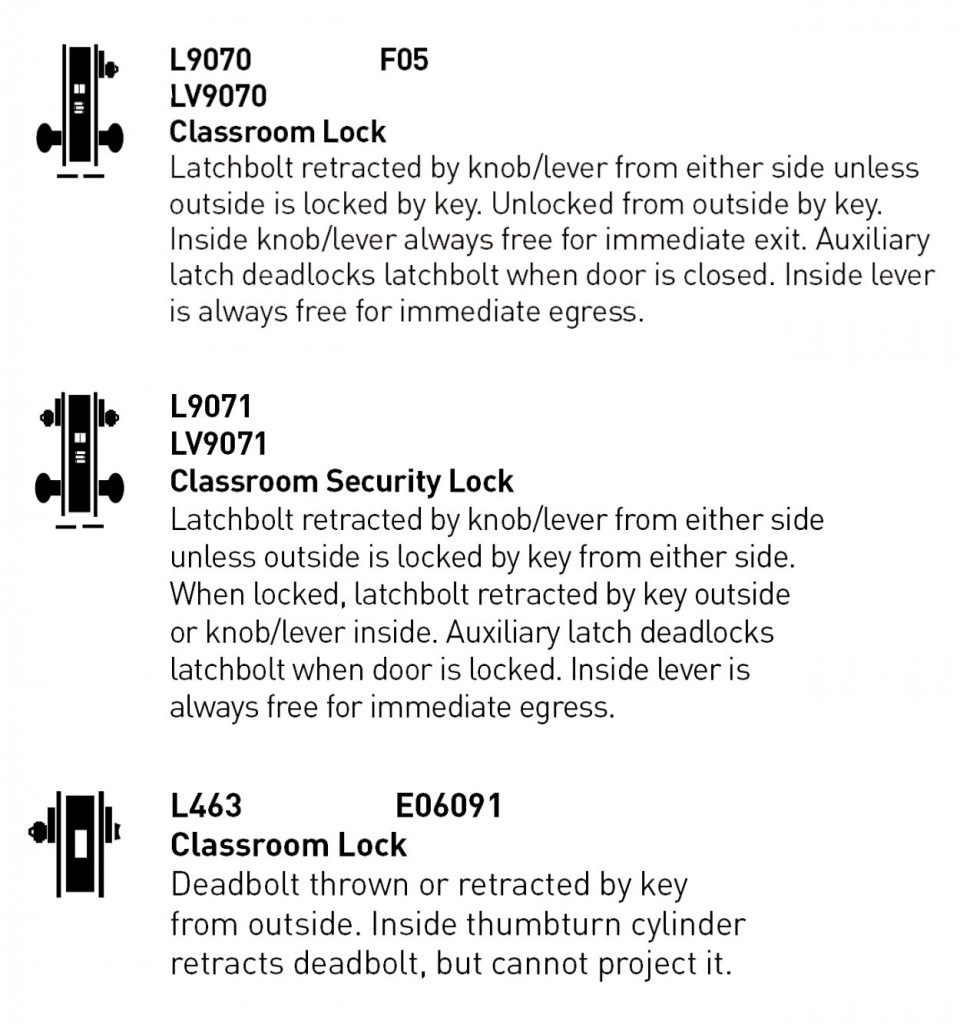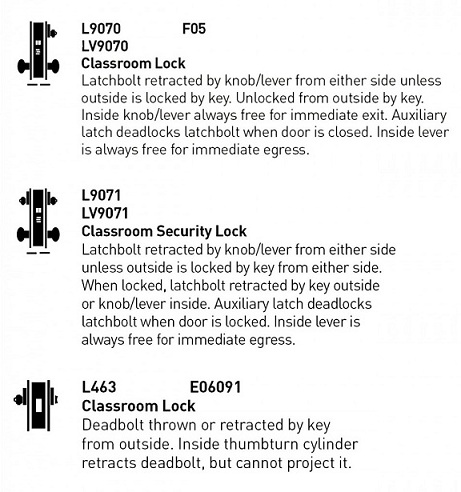 It’s funny how some things stick in your mind, and even funnier that I have “hardware memories” from way back. I remember a rumor going around my 7th grade Home Ec class that another class had locked our teacher, Mrs. Cross, out of the classroom, and that she had cried. So sad!
It’s funny how some things stick in your mind, and even funnier that I have “hardware memories” from way back. I remember a rumor going around my 7th grade Home Ec class that another class had locked our teacher, Mrs. Cross, out of the classroom, and that she had cried. So sad!
I’m sure that’s why classroom function locks were invented…to protect all of the Mrs. Crosses of the world. I’ve recently been asked how classroom function locks and deadlocks work, so here goes…
A classroom function lockset is controlled by using a key in the outside cylinder. The inside lever always provides free egress. The outside lever can be locked or unlocked only by someone with the key. There is no pushbutton or thumbturn on the inside that could be used by a rowdy band of 7th grade seamstresses. This function is not just for classrooms…it can be used in any location where control over the locking/unlocking is more important than the convenience offered by a pushbutton or thumbturn (office function).
Several years ago a new type of classroom function lock was introduced, called the “classroom security function” or “security classroom function,” depending on who you’re talking to. This function has two cylinders, which can cause a case of mistaken identity when it’s assumed to be an institutional function (locked on both sides, preventing access AND egress). The inside cylinder on a classroom security lock actually controls the outside lever – the inside lever always allows free egress. The ability to lock the outside lever without opening the door or stepping out into the corridor protects teachers from exposure during a lock-down emergency.
A classroom function deadlock is often used with push/pull hardware on entrance doors to multi-stall bathrooms, and I’ve had several code officials question their use over the years. In all cases, once I explained how the lock worked, the code official allowed the application. To lock a classroom function deadlock, you need to use the key to project the bolt. The key can also be used to retract the bolt. There is a thumbturn on the inside, but it will not project the deadbolt; it will only retract it. Similar to a classroom function lockset, only the person with the key has control over locking the door. If someone is accidentally “locked in,” they can use the thumbturn to retract the bolt for egress.
You need to login or register to bookmark/favorite this content.






Hello Lori,
interesting that you remember a teacher (Mrs Cross) getting locked out of her classroom, strange, same thign happened in the high school i went to, wasnt her classroom she was LOCKED IN and could not get out, i know i usually am found commenting on your closer related postings, but this was was a good read and deserves a comment from a closer geek.
what happened to me was that the home ec teacher she went into the copy machine room and when she went to make her exit, the inside knob fell off the shaft (other knob falling onto floor on hallway side) she was only left with 2 options, calling maintenance or crawling out the window (wasn’t the smartest idea, as it was a courtyard layout and her clothing was not all the best to climb through a window in) well that’s how I met the maintenance man at my high school, he was tapping pins out of hinges and while i passed by wondering what happened. when this happens and you have LCN 4040 installed on push side with trapped teacher and custodian on pull side pulling hinge pins, that’s the only time LCN is NOT your friend, because of the geometry of arm change when prying the door out of opening from hinge side (its stronger)
end result was teacher got restless and climbed out through the room window (good thing copy room is on first floor!)
another memory was another teacher with a loose doorknob, math teacher there, instead of calling maintenance, she called a door company that charged her $45+ JUST TO TIGHTEN THE SET SCREW ON KNOB!
another good one was the homeroom teacher (mrs meuller) i had that had a sweltering alternative to liquid wrench/WD-40 (SQUEAAAAAAAK!!!) this woman would RAISE THE HUMIDITY of the room and turn the classroom into a sauna to quiet the squeaker (squeaking was found to be from closer’s arm and top hinge) so it seems that that teacher she would rather be sweating instead of smelling petroleum distillates (the oil and propellant used in aerosol spray lubricant).
worked really well but always had to have windows open there, didn’t bother me.
another memory was when same said teacher PANICKED (as if someone had a medical emergency) when the door didn’t shut all the way one afternoon, (I’m sure LCN technical support/engineers are aware of the “fainting” closer phenomenon) its usually as a result of improper adjustment of closer or a clog in valves or wrong oil used in the closer (her door was one of first that I fixed during my high school years)
Good Morning Lori,
Thanks for the article on Classroom Safety Locks. From day one I had reservations about the function as, if there was a Lock Down, the teacher may have to open the Classroom entrance door to determine if the outside Lever was locked. Schlage came out with a bulletin on Oct 2, 2001 adding Classroom Security Indicators for D and L locks. After which I never Specified a K-12 Project without a ” Locked ” Indicator on the inside trim. Problem. The Indicator # for the L lock originally used was used for another ” Do Not Disturb ” function. Finally after contacting engineering over years to get a proper Indicator # on July 27, 2009 we were given – 09-611 x L358-375 [ $ 82.00 list ] to be written as a separate line item with the L lock. To date we have had no confusion re: the Locked Indicator for the L Lock. The ND offers it as an add. FYI. Have a great day !! Bill Ab